Featured
- Get link
- X
- Other Apps
Navigating the Urban Lifeline: Exploring Mumbai's Railway System
Title: Navigating the Urban Lifeline: Exploring Mumbai's Railway System
Introduction:
In the bustling metropolis of Mumbai, a city that never sleeps, the local railway system stands tall as the lifeline of its transportation network. Connecting millions of commuters and covering vast distances, the Mumbai railways are an integral part of the city's identity. In this blog post, we will delve into the rich history, incredible scale, and Rhythm of life on Mumbai's railway tracks.
1. A Brief History:
Mumbai's railway system has a captivating history that dates back to the mid-19th century. The first train in Mumbai ran on April 16, 1853, between Bori Bunder (now known as Chhatrapati Shivaji Maharaj Terminus) and Thane. The railway network expanded rapidly, catering to the growing population and linking various parts of the city. Today, Mumbai boasts one of the most extensive suburban railway systems in the world.
2. The Three Main Lines:
The Mumbai railway network primarily consists of three main lines: Western, Central, and Harbour. The Western Line connects the city's western suburbs to the southern part of Mumbai. The Central Line serves as a lifeline for commuters traveling between the northern, eastern, and southern parts of the city. The Harbour Line provides connectivity to the eastern suburbs, improving accessibility to places like Navi Mumbai.
3. The Lifeline of Millions:
Every day, millions of Mumbaikars travel local trains to commute to work, school, and various other destinations. The railway system plays a pivotal role in easing the daily struggles of the city's residents, especially during peak hours when overcrowded trains become a common sight. The suburban trains are known for their efficient service, running with remarkable precision despite the heavy rush.
4. The Dabbawalas and Mumbai Railways:
One of the most fascinating aspects of Mumbai's railway system is its symbiotic relationship with the famous dabbawalas. These dedicated individuals deliver lunchboxes to thousands of office-goers across the city. The dabbawalas utilize the railway system to transport the lunchboxes from homes to workplaces, showcasing the remarkable coordination and efficiency of both the dabbawalas and the Mumbai railways.
5. Iconic Railway Stations:
Mumbai is home to numerous iconic railway stations, each with its own charm and significance. Chhatrapati Shivaji Maharaj Terminus, a UNESCO World Heritage Site, stands as an architectural marvel, showcasing a blend of Victorian Gothic and Indian architectural styles. Other notable stations include Churchgate, Dadar, Victoria Terminus, and Bandra Terminus, which are not only transport hubs but also architectural landmarks.
6. Challenges and Future Developments:
While the Mumbai railway system has played a vital role in the city's growth, it also faces numerous challenges. Overcrowding, infrastructure maintenance, and the need for modernization are among the key issues. However, efforts are being made to address these challenges. Projects like the Mumbai Metro and the upcoming Mumbai-Ahmedabad High-Speed Rail are set to provide alternative transportation options and ease the burden on the railways.
Conclusion:
The Mumbai railways are not just a means of transportation but an embodiment of the city's spirit, diversity, and resilience. They reflect the pulse of Mumbai, where people from various walks of life come together and create a vibrant tapestry of experiences. Navigating the intricate railway system in Mumbai is an adventure in itself, offering a unique glimpse into the heart and soul of the city.
Popular Posts
Exploring the Majestic Forts of Maharashtra: A Journey into History and Beauty
- Get link
- X
- Other Apps



Comments
Post a Comment